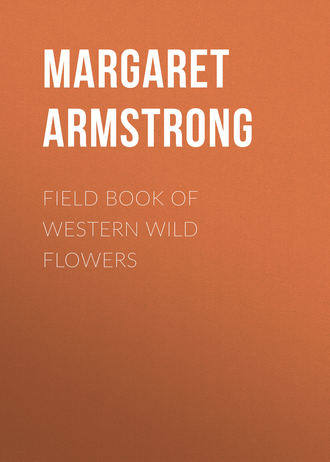 полная версия
полная версияField Book of Western Wild Flowers
There are many kinds of Papaver; with milky juice, leaves lobed or cut, nodding flower buds, showy regular flowers, with two or three sepals and four to six petals. The stigmas are united to form a disk with rays and the fruit is a round or oblong capsule, opening near the top. Both the Latin and common name, Poppy, are ancient. Opium is made from P. somníferum of the Mediterranean.
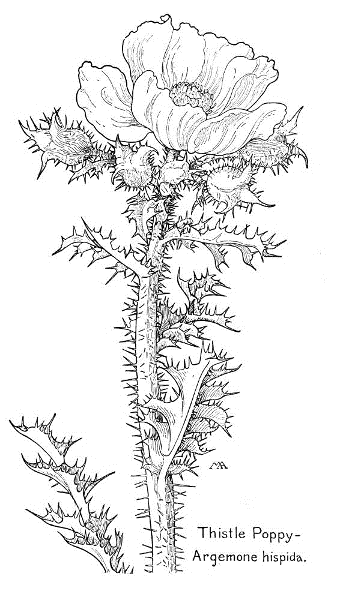
Thistle Poppy – Argemone hispida.
Wind Poppy
Papàver heterophýllum
Red
Spring
California
A slender, graceful plant, one or two feet tall, with smooth, branching, purplish stems, smooth leaves, variously cut and lobed, and charming flowers, gay yet delicate. They are about an inch and a half across, usually with four, scarlet petals, each with a spot of maroon at the base, and a bright-green pistil and maroon filaments with pale-yellow anthers. The buds and seed-pods are smooth. This varies a good deal, smells strong of opium when picked, and its flowers glow like jewels among the underbrush on open hillsides, but fall to pieces when gathered.
There are a good many kinds of Eschscholtzia, with bitter, watery juice; leaves alternate, cut into many fine divisions; buds erect; flowers yellow; receptacle cuplike, often with a rim; the two sepals united to form a pointed cap, which is pushed off by the four petals as they expand; stamens numerous, with short filaments and long anthers; style very short, usually with four stigmas; pod long, narrow and ribbed, containing many seeds. These plants were collected at San Francisco in 1816 by von Chamisso, a German poet and naturalist, and named in honor of his friend Eschscholtz, a botanist.
California Poppy
Eschschóltzia Califórnica
Yellow
Spring
Cal., Oreg.
Probably the most celebrated western flower and deservedly popular. It varies a great deal in general form and coloring, but is usually a fine plant, over a foot tall, with stems and leaves a beautiful shade of light bluish-green, and the flowers two or three inches across, usually bright-yellow, shading to orange at the base, but sometimes almost cream-color. They open in sunlight and when blooming in quantities are a beautiful sight, covering the hillsides with a cloth of gold. In southern Arizona a similar kind often borders the dry beds of streams with bright color, with much the same value in the landscape as the Marsh Marigolds along New England streams. It is the State flower of California and has many poetic Spanish names, such as Torosa, Amapola, and Dormidera, besides Copa de Oro, meaning "Cup of gold."
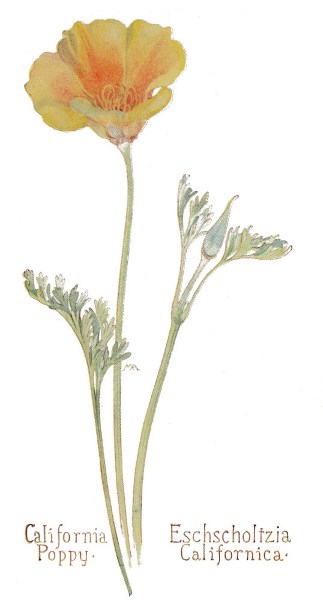
California Poppy – Eschscholtzia Californica.
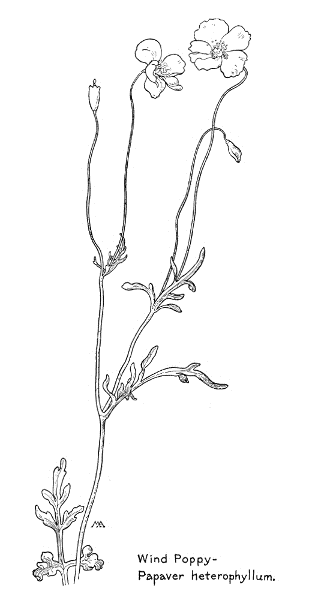
Wind Poppy – Papaver heterophyllum.
There are several kinds of Dendromecon, smooth shrubs, with alternate, toothless, leathery leaves and yellow flowers, with two sepals and four petals; stamens numerous, with short filaments; ovary with a short style and two, oblong stigmas. The name is from the Greek for "tree" and "poppy."
Tree Poppy
Dendromécon rígida
Yellow
All seasons
California
This is not a true Poppy, but the flowers are sufficiently like to be quite surprising when we find them growing on what appears to be a small willow tree! It is a handsome and decorative shrub, both in form and color, two to eight feet high, with pale woody stems, the main stem with shreddy bark, and light bluish-green foliage, the leaves something like those of willow, but quite stiff and leathery, with a little pointed tip, the short leaf-stalks twisted so as to bring the leaf into a vertical position. Sprinkled all over the bush are numbers of beautiful, clear golden-yellow flowers, one to three inches across, with orange-colored anthers and a pale-yellow pistil. This grows on dry, sunny hillsides, at middle altitudes, and is common in southern California, but is particularly fine near Santa Barbara. The flowers have a slight smell like cucumber and may be found in bloom at all seasons of the year. The ribbed seed-pod is long and narrow.
There is only one kind of Platystemon, with stem leaves opposite or in whorls; sepals three, soon falling; petals six; stamens many, with broad, flat filaments. The numerous pistils are at first partly united, forming a compound ovary; when ripe they separate into knotted pods, which break apart between the seeds. The name means "broad stamens."
Cream-cups
Platystèmon Califórnicus
Cream-color
Spring
Cal., Oreg., Ariz.
Pretty graceful plants, their creamy blossoms often whitening the spring meadows. The slender hairy stems are about a foot tall, the leaves and the nodding buds light-green and hairy, and the pretty flowers, about an inch across, are delicate cream-color, the petals often stained with bright-yellow, either at the tip or base, or both, with pretty creamy centers. This is common in the foothills, plains, and valleys.
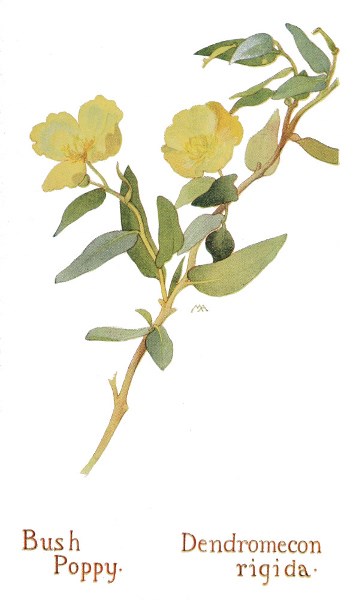
Bush Poppy – Dendromecon rigida.
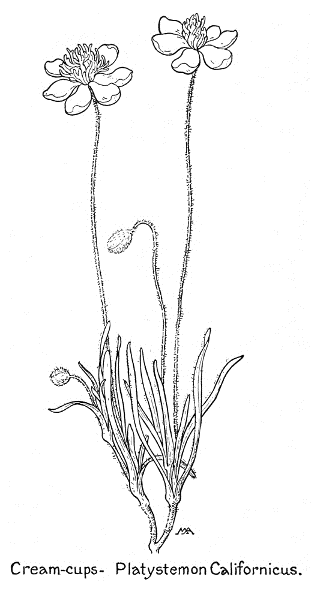
Cream-cups – Platystemon Californicus.
BLEEDING HEART FAMILY. Fumariaceae
A small family, widely distributed; very smooth, tender, perennial herbs, with watery juice; alternate, compound leaves, finely cut, lobed and fringed into many divisions, and irregular, perfect flowers, of peculiar shape, with two, scale-like sepals, and four petals, the inner pair narrower than the outer and united by their tips over the stamens and style. The six stamens are in two, equal sets, the filaments of each set somewhat united, the middle anther of each set with two cells, the others with only one. The superior ovary develops into a long, dry, one-celled capsule, containing shiny, black seeds. This family has been united to the Poppies by Bentham and Hooker, because the plan of the flowers is similar, though their appearance is unlike.
There are several kinds of Bicuculla, natives of North America and Asia; perennials, with beautiful foliage and decorative flowers, of the curious and intricate shape we are familiar with in old-fashioned gardens. The pedicels have two bracts; the corolla is heart-shaped at base; the outer pair of petals are oblong and concave, with spreading tips and spurred or pouched at base, the inner pair are narrow and clawed, with crests or wings on the back; the style is slender, with a two-lobed stigma, each lobe with two crests. The creeping rootstock is surrounded by a bulb-like cluster of fleshy grains. These plants are often called Dutchman's Breeches, from the shape of the flower, which, of course, also gives the pretty name Bleeding Heart. Bicuculla is from the Latin, meaning "double-hooded."
Bleeding Heart
Bicucúlla formòsa (Dicentra)
Pink
Summer
Cal., Oreg., Wash.
This is a very beautiful and interesting plant, about two feet tall, with delicate pale-green leaves, beautifully cut and lobed, all from the root, with very long leaf-stalks, and a few, graceful sprays of purplish-pink flowers, each about three-quarters of an inch long. This has a fleshy, spreading rootstock and grows in shady spots, in rich, moist woods, at moderate altitudes, but is not very common. It is found in the Yosemite Valley. B. uniflòra is a diminutive alpine plant, from one to three inches high, usually with only one white or flesh-colored flower, about half an inch long, which is often hidden among dead leaves. This grows in rich soil on mountain sides in the Wasatch and Teton Mountains and in the Sierra Nevada, and is found in the Yosemite Valley and on Mt. Lyall, at a height of ten thousand five hundred feet. This is called Squirrel Corn and Steer's Head.
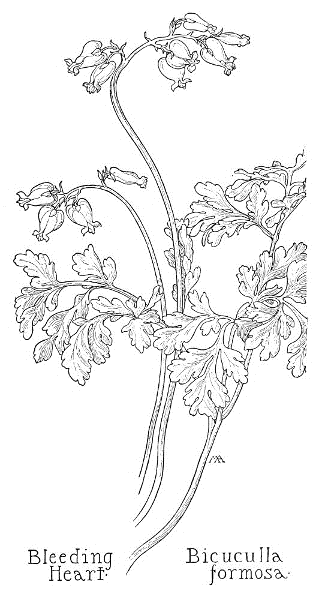
Bleeding Heart – Bicuculla formosa.

Golden Eardrops
Bicucúlla chrysántha (Dicentra)
Yellow
Summer
California
The general appearance of this handsome plant is striking and Japanese in effect, and the coloring of the feathery, pale-green foliage and the golden-yellow flowers is exceedingly odd and beautiful. The large, finely-cut leaves are sometimes a foot long, and resemble delicate ferns, and the smooth, stout, rather coarse flower-stems bear a few pretty flowers, which are a soft shade of yellow, about three-quarters of an inch long, the usual Bleeding Heart shape, but not drooping, and with a strong narcotic odor, much like that of poppies. This is sometimes as much as four feet high and grows in sunny places on dry ridges in the Coast Ranges, but is nowhere common.
There are many kinds of Capnoides, natives of the north temperate zone and Africa. They have oddly-shaped flowers, something like Bleeding Heart, but with only one spur, at the back on the upper side, instead of two. The name is from the Greek, meaning "smokelike," in allusion to the odor of some kinds.

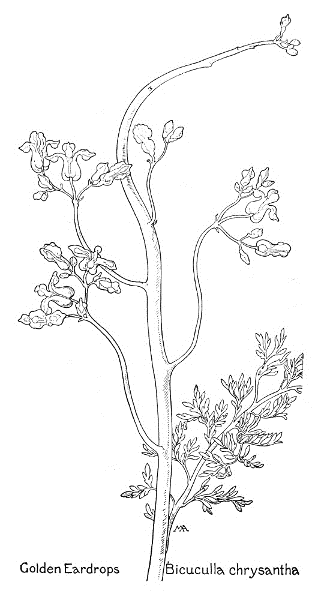
Golden Eardrops – Bicuculla chrysantha.

Golden Corydal
Capnoìdes aùreum
(Corydalis)
Yellow
Spring
West
This has hollow, branching and spreading stems, from six to fourteen inches tall, with very pretty, delicate, pale-green foliage and bright-yellow flowers, each about half an inch long, on slender pedicels, in a loose cluster. The spurs give them a quaint and pert effect. The style stays on the tip of the long curved capsule, which looks like a bean-pod, drooping or sticking out at an awkward angle from the stem. This is especially fine in some of the mountain valleys in Utah, making beautiful clumps of foliage; it is widely distributed and is also found in the East. In the West it is sometimes called Dutchman's Breeches and confused with that plant, but rather absurdly so, for the Dutchman could have only one leg!
Pink Corydalis
Capnoìdes Scoúleri
(Corydalis)
Pink
Summer
Wash., Oreg.
A very beautiful and decorative plant, two or three feet tall, with large, exceedingly graceful leaves, vivid yet delicate in color and thin in texture, beautifully cut and lobed. The flowers are about an inch long, pale-pink shaded with deeper color, each with a long, cylindrical spur, and form pretty clusters, which show up very effectively against the tender green of the large clumps of delicate foliage, which are conspicuously beautiful. This grows in rich soil, in mountain woods, and is charming in the forests in Mt. Rainier National Park.

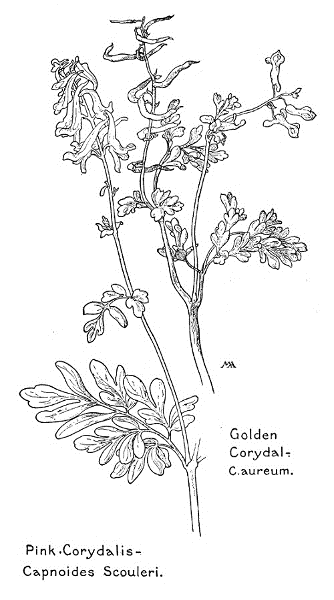
Pink Corydalis – Capnoides Scouleri.
Golden Corydal – C. aureum.
MUSTARD FAMILY. Cruciferae
A large family, widely distributed. Both the English and Latin names are appropriate, for the watery juice of these plants is pungent, like mustard, and the flowers spread out their four petals in the form of a cross. They are herbs, the leaves alternate or from the root, usually with no leaf-stalks. The flowers have four petals, with claws; four sepals, the two outer ones narrow, apt to drop off; six stamens, two of them short. The ovary is superior, usually with a single style and stigma, and usually develops into a pod, divided in two by a transparent partition, which remains after the pod has opened from below; in some kinds the pod remains closed. The flowers generally grow in clusters and though they are often small they produce honey and so are frequented by bees and flies. The family is easily recognized by the four petals and in most species by two stamens being shorter than the others, but the flowers are so much alike that the various kinds have to be determined by examining the fruit. Radish and Horse-radish, Mustard and Water-cress all belong to this family, as well as many familiar garden flowers, such as Sweet Alyssum, Candytuft, Rockets, and Stocks, and many are common weeds, such as Peppergrass and Shepherd's Purse.
There are several kinds of Dentaria, smooth perennials, with rather large white or pink flowers and tuberous rootstocks.
Milk Maids, Pepper-root
Dentària Califórnica
White, pink
Spring
Cal., Oreg.
A charming plant, with a purplish stem, from six inches to two feet tall, and pretty leaves, varying in shape, those from the root being roundish in outline, or with three leaflets, but the stem-leaves with three or five leaflets. The flowers are about three-quarters of an inch across, with pure-white or pale-pink petals. This is one of the loveliest of the early spring flowers in the Coast Ranges and usually found in damp spots, both in woods and open places, often whitening the meadows with its blossoms.
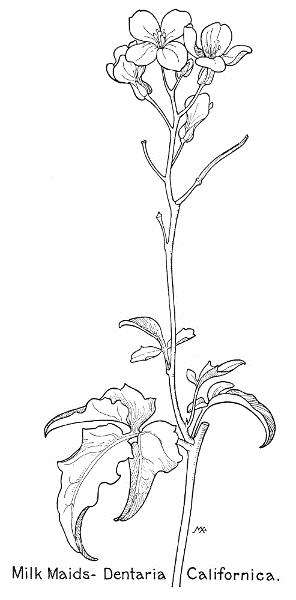
Milk Maids – Dentaria Californica.
There are a good many kinds of Thelypodium, natives of North America, all western or southwestern; mostly smooth plants, the leaves usually with leaf-stalks, the flowers in clusters; stamens long, conspicuous, with very narrow, arrow-shaped anthers; pods long, cylindrical or four-sided, often twisted, sometimes on a slender stalk; seeds oblong, flattish, in one row in each cell.
Thelypòdium torulòsum
Lilac
Spring, summer
West, etc.
This has small flowers, but often grows in such quantities on the flats near Salt Lake that it tints the fields with purple. The purplish stem is from twelve to fifteen inches tall and the leaves are light bluish-green and very smooth, the root-leaves with long leaf-stalks, and the stem-leaves arrow-shaped and clasping at base. The flowers are about half an inch across, with a purplish-tinged calyx and pale pinkish-lilac petals, and form flat-topped clusters. The pods are spreading and rather knobby. This usually grows on dry hills, reaching an altitude of over nine thousand feet, as far east as Wyoming.
There are many kinds of Arabis, widely distributed, with small, white or purplish flowers.
Fendler's Arabis
Árabis Féndleri
Magenta
Spring
Arizona
This is a rather pretty plant, a foot or more tall, with more or less hairy stems and leaves and pretty clusters of magenta flowers, each about a quarter of an inch across. It grows on the rim of the Grand Canyon.
There are many kinds of Erysimum, most abundant in Europe and Asia. They are usually biennial or perennial, more or less downy; mostly with yellow flowers; the pods long, narrow and squarish or flattish, rarely round, with numerous seeds, in one row. In Europe these plants often grow in the crannies of old walls, hence the common name.
Western Wallflower
Erýsimum ásperum
Orange, lemon-yellow
Spring, summer
West, etc.
The vivid glowing orange of these handsome flowers is exceedingly effective among the dark tree-trunks of the mountain forests where they often grow. They are widely distributed as far east as Ohio. The stout, purplish stems are from one to two feet tall and the long, narrow leaves, often toothed, are apt to be purplish on the under side, and both stem and leaves are rather rough. The fragrant flowers, each about three-quarters of an inch across, form a handsome cluster, about three inches across. The calyx is yellow, the pistil green, and the anthers brown. The conspicuous, four-sided pods are spreading or erect, from one to five inches long, with a stout beak. In the high mountains the orange-color gives way to the variety perénne, with lemon-colored flowers, perhaps commoner than the orange, not so tall, and wonderfully handsome in the Wasatch Mountains, around Mt. Rainier and similar places, and widely distributed. The Cream-colored Wallflower, E. capitàtum, blooms early, growing near the coast; the flowers large, handsome, but not sweet-scented.
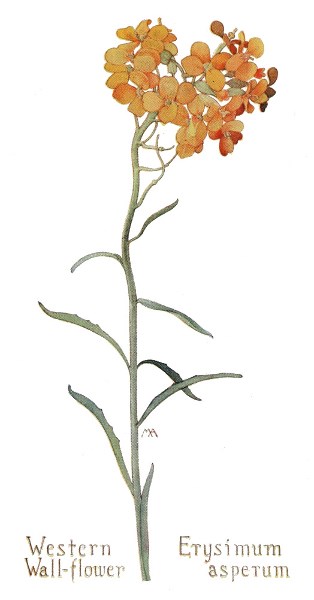
Western Wall-flower – Erysimum asperum.
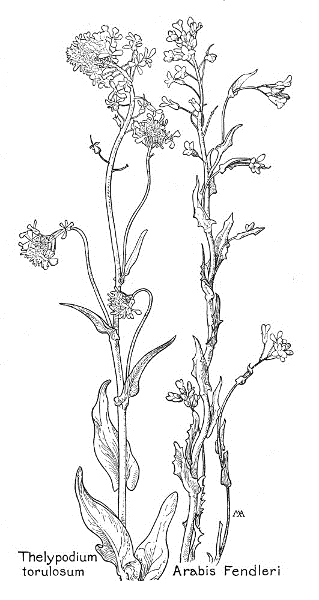
Thelypodium torulosum.
Arabis Fendleri.
There are a good many kinds of Thlaspi, of temperate and arctic regions: smooth low plants, mostly mountain; root-leaves forming a rosette; stem-leaves more or less arrow-shaped and clasping; flowers rather small, white or purplish; sepals blunt; style slender, sometimes none, with a small stigma; pod flat, roundish, wedge-shaped, or heart-shaped, with crests or wings.
Wild Candytuft, Pennycress
Thláspi glaùcum
White
Spring, summer, autumn
Northwest and Utah
A rather pretty little plant, with several flower-stalks, springing from rosettes of leaves, dull-green, somewhat purplish and thickish, smooth and obscurely toothed, all more or less covered with a "bloom"; the flowers small, slightly fragrant, forming clusters less than an inch across, the white petals longer than the thin, greenish sepals. This grows on moist, mountain slopes. T. alpéstre, of the Northwest, is similar, but without "bloom."
There are only a few kinds of Dithyrea, grayish, hairy plants, resembling Biscutella of the Mediterranean, with yellowish or whitish flowers.
Dithýrea Wislizéni
White
Summer
Ariz., New Mex., Tex., Okla., Ark.
A little desert plant, from six to twelve inches tall, with branching stems; pale, yellowish-green, downy leaves, about an inch long, with wavy or toothed margins; small white flowers and funny little seed-pods, sticking out at right-angles from the stem. This grows at an altitude of three to four thousand feet and is found in the Petrified Forest.
There are many kinds of Streptanthus, difficult to distinguish, smooth plants, often with a "bloom"; stems branching; leaves often clasping at base, the lower ones usually more toothed or lobed than the upper. The flowers are very peculiar in shape, not like most Mustards, but suggesting the shape of a Bleeding Heart flower; the sepals usually colored like the petals, two or all of them bulging at base, so that the calyx is broad below and contracted above; the corolla regular or irregular, the petals purple or white, with claws and narrow, wavy or crisp borders; the stamens four long and two short, or in three unequal pairs, the longest pair often united below; the pods long, narrow, flattish or cylindrical, on a broad receptacle; the seeds flat and more or less winged. These plants are called Jewel-flower, but the name does not seem particularly appropriate.
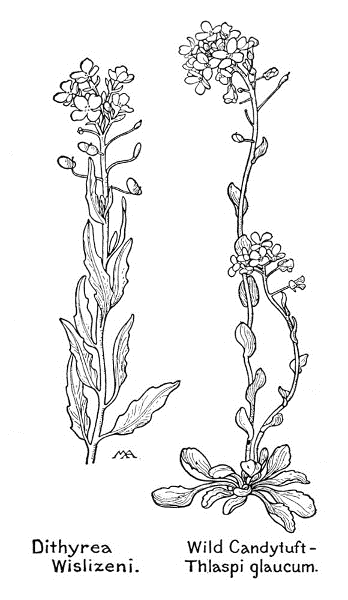
Dithyrea Wislizeni.
Wild Candytuft – Thlaspi glaucum.
Shield-leaf
Streptánthus tortuòsus
Yellowish, purplish
Summer
California
Nothing about this odd-looking plant is pretty and it almost seems as if it were trying to make up by eccentricity for its lack of beauty. It is common in dry, sandy places in the mountains and our attention is first attracted to the tall, branching stalks, because they are strung with such queer-looking leaves. In summer the upper ones are bright-yellow or dull-purple and they clasp the stem and curve over, so that they look like small brass shields, pierced by the stem. There are three or four of these curving leaves, very smooth and shiny, and several more below, which are flatter and dark-green, and the stem, from six inches to three feet high, is oddly twisted and leans to one side. The small flowers are yellowish or mauve, veined with purple, less than half an inch long and peculiar in shape. The contrast in color between the flowers and leaves is very odd and very ugly, but as if this were not enough, later in the season the curious thing hangs itself with ridiculously long, slender pods, like great hooks, and looks queerer and more disheveled than ever.
Arizona Streptanthus
Streptánthus Arizònicus
White
Spring
Arizona
Prettier and not so queer-looking as the last. The leaves are arrow-shaped, clasping at base, rather leathery, bluish-green, with a "bloom" and tinged with purple on the backs, the lower ones toothed, and the pods are about two inches long, flat and tinged with purple. The flowers are half an inch long, pearly-white, the petals yellowish, veined with purple, and are quite pretty. This grows in dry places.
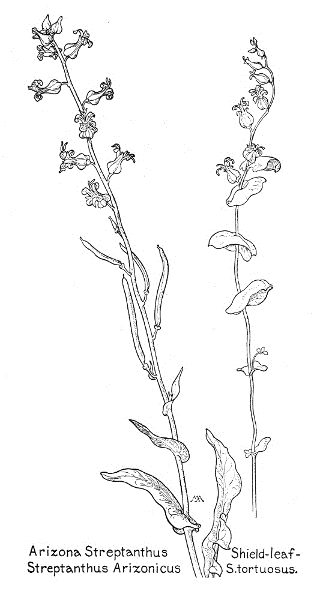
Arizona Streptanthus – Streptanthus Arizonicus.
Shield-leaf – S. tortuosus.
There are only a few kinds of Stanleya, all western; tall, stout, smooth perennials, or biennials, with a "bloom"; flowers large, mostly yellow, without bracts, in long, terminal, clusters; sepals long, narrow; petals long, narrow, with long claws; stamens six, very nearly equal; ovary on a short stalk, with a short style or none; pods long, narrow and flattish, with long stalks; seeds numerous. Named for Lord Edward Stanley, President of the Linnaean Society.
Golden Prince's Plume
Stánleya pinnatífida
Yellow
Spring
Southwest and New Mex.
The pretty common name of this tall, handsome plant was given by Helen Hunt Jackson and the long, feathery wand of numerous blossoms is beautiful and suggests a plume. On the other hand, the straggling flowers have such long, narrow, curling petals, the threadlike filaments look so much like curling antennae and the long, thin pods stick out so awkwardly, like insects' legs, from among the flowers on the lower part of the stalk, that we find the general effect is rather weird and spidery. In fact the plant I drew had a large yellow spider, precisely the color of the flowers, half-concealed among them. The stem is from two to five feet high; the leaves are smooth, pale bluish-green, the lower ones with leaflets and a leaf-stalk, and the flowers are bright-yellow, or cream-color, about an inch across. This grows usually in dampish spots, in arid regions. The picture is of one I found in Indian Garden Canyon, a branch of the Grand Canyon.
Dryopétalon runcinàtum
White
Spring
Arizona

